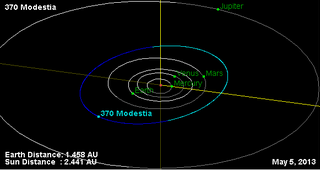
Klytia is a main-belt asteroid. It was the second and last asteroid discovery by the prolific comet discoverer Horace Tuttle, on April 7, 1862. It is named after Clytia, who loved Helios in Greek mythology. Of the first one hundred numbered asteroids, Klytia is the smallest.

Vincentina is a fairly large main belt asteroid.

Augusta is a main-belt asteroid, discovered on 31 March 1886 by astronomer Johann Palisa at Vienna Observatory, Austria. The stony S-type asteroid measures about 12 kilometers in diameter. It is the first-numbered member of the Augusta family, after which the small Asteroid family and subgroup of the main-belt has been named. Augusta was named after the German–Austrian writer Auguste von Littrow (1819–1890), widow of astronomer Carl Ludwig von Littrow, who was a former director of the Vienna Observatory.

Gisela is an asteroid belonging to the Flora family in the Main Belt that has an unusually high albedo.

Gabriella is a typical Main belt asteroid.

Ninina is a large main-belt asteroid. It was discovered by Auguste Charlois on February 11, 1893, in Nice. The reference of its name is not known, though Ninine is a French personal name.

Apolonia is a large Main belt asteroid. It was discovered by Auguste Charlois on 8 March 1893 in Nice.

Georgia is a typical Main belt asteroid. It is classified as an X-type asteroid.

Havnia is a typical Main belt asteroid.
Padua is a main belt asteroid that was discovered by Auguste Charlois on 17 March 1893 in Nice. It was named after the city of Padua, near Venice, Italy.

Modestia is probably a typical Main belt asteroid. It was discovered by Auguste Charlois on 14 July 1893 in Nice.

Bohemia is a sizeable Main belt asteroid. It was discovered by Auguste Charlois on 16 July 1893 in Nice.

Burgundia is a typical main belt asteroid that was discovered by Auguste Charlois on 18 September 1893 in Nice. It was named for the former French region of Burgundy. It is one of seven of Charlois's discoveries that was expressly named by the Astromomisches Rechen-Institut.
Monachia is an asteroid orbiting within the Flora family in the Main Belt.
871 Amneris is a minor planet orbiting the Sun. It is the namesake of the Amneris family, a subgroup of the Flora family of Main Belt asteroids.
5642 Bobbywilliams, provisional designation 1990 OK1, is an eccentric, stony asteroid and Mars-crosser from the inner regions of the asteroid belt, approximately 4.7 kilometers in diameter.
7346 Boulanger, provisional designation 1993 DQ2, is a Koronian asteroid from the outer regions of the asteroid belt, approximately 7.4 kilometers (4.6 miles) in diameter. It was discovered on 20 February 1993, by Belgian astronomer Eric Elst at the CERGA Observatory in Caussols, southeastern France. It was named after French Enlightenment philosopher Nicolas Boulanger.
1818 Brahms, provisional designation 1939 PE, is an asteroid from the inner regions of the asteroid belt, approximately 6 kilometers in diameter. It was discovered on 15 August 1939, by German astronomer Karl Reinmuth at Heidelberg Observatory in southern Germany. The asteroid was named after composer Johannes Brahms.
2905 Plaskett, provisional designation 1982 BZ2, is a stony Gefionian asteroid from the central regions of the asteroid belt, approximately 10 kilometers in diameter. It was discovered on 24 January 1982, by American astronomer Edward Bowell at the Anderson Mesa Station near Flagstaff, Arizona. The asteroid was named after Canadian astronomers John Stanley Plaskett and Harry Hemley Plaskett.
6144 Kondojiro (1994 EQ3) is an asteroid discovered on March 14, 1994 by Kin Endate and Kazuro Watanabe at the Kitami Observatory in eastern Hokkaidō, Japan. It is named after Jiro Kondo, a Japanese Egyptologist and professor of archaeology at Waseda University.












